Wedding Flowers: A Practical Guide for Every Season, Budget, and Style
The best results always come from a simple plan that matches your venue, season, palette, and budget. This guide shows you how to choose flowers with confidence, avoid costly mistakes, and still keep the magic. You will see real life tips, short stories with lessons, and sample budgets. We will cover fragrance and allergy notes, common myths, country inspired touches, and color based suggestions. If you want beautiful and affordable wedding flowers, a thoughtful plan matters more than an unlimited budget.
How to choose: a simple framework
Start with four anchors. First is the venue. Ceiling height, temperature, and wind exposure decide the scale and mechanics. Second is the season. Seasonal flowers look fresher, last longer, and travel less. Third is the palette. Choose one anchor flower you love and two supporting textures. Fourth is the budget. Allocate the largest share to items that appear in the most photos and stay closest to guests. This usually means the bridal bouquet, personal flowers, and the head table. Add one wow moment such as an arch or staircase install. Then finish with simple centerpieces that repeat clean shapes and foliage.
Guest comfort and fragrance tolerance
Fragrance can be wonderful in open spaces and overwhelming in small rooms. If your guest list includes sensitive noses or asthma, lean on low fragrance options such as ranunculus, lisianthus, hydrangea, orchids, and most chrysanthemums. Avoid heavy pollinators near food and use minimal lilies indoors because pollen stains and the scent can be strong. Remove anthers from lilies if you use them. Always ask your florist to confirm fragrance intensity for your exact varieties. Place very fragrant blooms at the ceremony where air flow is better. Keep reception tables light and fresh so guests can talk and eat comfortably.
Logistics and staffing
Great flowers rely on good logistics. Ask how your designs will be transported, how long installs take, and whether your venue allows early access. Outdoor pieces need secure mechanics and extra water. Heat, wind, and direct sun reduce vase life. Shade and hydration stations keep bouquets photo ready. Confirm who moves ceremony pieces to the reception to repurpose them. Ask for a floor plan that shows power, door widths, and ceiling rigging. Confirm load in time, load out time, and where waste goes. These details prevent rush fees and ensure the design you approved is the design you receive.
Budget and prices: what drives cost
Flowers are like fashion. The same recipe looks very different when you change stem quality, stem count, and mechanics. Labor is often half the price because skilled hands condition flowers, build structure, and keep everything fresh under time pressure. Large installs need ladders, lifts, and extra staff. Urgent timelines increase cost. Imported out of season flowers cost more. Local field grown flowers cost less per stem but may require flexible palettes. Reusing ceremony pieces saves money and waste. If you must choose, invest in the bouquet and key portraits. Centerpieces can be simple and still feel luxurious with good linens and candlelight.

Typical price ranges in the United States
These are common 2025 ranges for straightforward designs. A classic bridal bouquet is often 150 to 350 dollars with premium garden roses or orchids reaching 400 to 600 dollars. Bridesmaid bouquets are often 55 to 120 dollars. Boutonnieres are often 12 to 25 dollars and corsages are often 25 to 45 dollars. Small guest table centerpieces are often 60 to 150 dollars when using roses, mums, and greenery. Lush compotes with peonies or orchids are often 175 to 350 dollars. Ceremony arches vary widely from 300 to 1,500 dollars for partial coverage and 2,000 to 6,000 dollars for full coverage depending on size and mechanics.
How to make it cheap and beautiful
Choose one focal flower you love and let supporting flowers do the heavy lifting. Repeat the same recipe across all centerpieces to speed production and reduce waste. Use potted plants or mixed greenery to fill space for staircases and stages. Repurpose ceremony arrangements to the reception. Place an arch behind the head table to frame photos for hours. Use tapered candles and textured linens to add depth so centerpieces can be smaller. Ask for premium blooms only where eyes linger such as bouquet centers and top table clusters. Commit to a flexible palette so your florist can buy the best value at market.
Seasons: what works and what to swap
Each season has stars and smart substitutes. Your florist can import many things year round. Seasonally aligned choices look fresher and stretch the budget. Use these ideas as a starting point and adjust by climate.

Spring weddings
Spring delivers ranunculus, anemones, tulips, sweet peas, spirea, lilac, viburnum, and early garden roses. Peonies start in late spring in many regions. Colors are soft and luminous. Hydrangea may be limited early outdoors but thrives in controlled environments. Use light mechanics because stems are tender. Keep centerpieces compact and airy. Outdoor ceremonies benefit from wind friendly flowers like tulips and ranunculus bundled tightly. Protect sweet peas and lilac from heat with water sources and shade. For fragrance sensitive guests, emphasize ranunculus and tulips rather than lilac and stock.
Summer weddings
Summer is generous. Dahlias, garden roses, lisianthus, hydrangea, zinnias, cosmos, delphinium, and sunflowers are abundant. Color saturation is strong and the days are long. Hydrangea drinks heavily and prefers a cool room. Orchids tolerate heat and travel well for destination events. Outdoor ceremonies need deep water sources and shade for staging. Choose hardy greens such as ruscus, salal, and olive for arches. Avoid dense low centerpieces in very hot tents without air movement because petals can bruise. If you want peonies in midsummer, expect imports and higher prices. Dahlias and garden roses are the practical romantic substitute.


Fall weddings
Fall brings dahlias at their peak, heirloom chrysanthemums, garden roses, amaranthus, smokebush, scabiosa, and berries. Palettes shift to caramel, burgundy, copper, and plum. Textures become richer. Candlelight reads beautifully with warm tones. Weather is friendly in many regions so large installs are easier. Avoid delicate blooms for outdoor mountain ceremonies with gusty winds. Use weighted stands and secure bases. Consider potted mums and grasses to build a generous aisle on a budget. If frost arrives early, be flexible. Field grown dahlias may end abruptly so have a backup recipe that leans on chrysanthemums and roses.
Winter weddings
Winter is elegant and clear. Amaryllis, roses, anthurium, orchids, hellebore, ranunculus, and evergreen textures define the season. White and green palettes shine with metallic accents. Use candlelight and reflective surfaces to amplify smaller arrangements. Hydrangea can work indoors but avoid unheated barns. Amaryllis is bold for ceremony pieces and can be reused at the reception. Hellebore looks delicate and needs excellent hydration. For coastal or tropical destinations, orchids offer consistent quality and survive travel. If you want peonies in winter, they will be imported and costly. Garden roses can deliver a similar mood with better availability.

Types of flowers by color
Color sets the tone long before guests read the menu. Use one anchor color with a supporting tint and a grounding neutral. These suggestions combine reliable availability with strong visual impact.
White and ivory
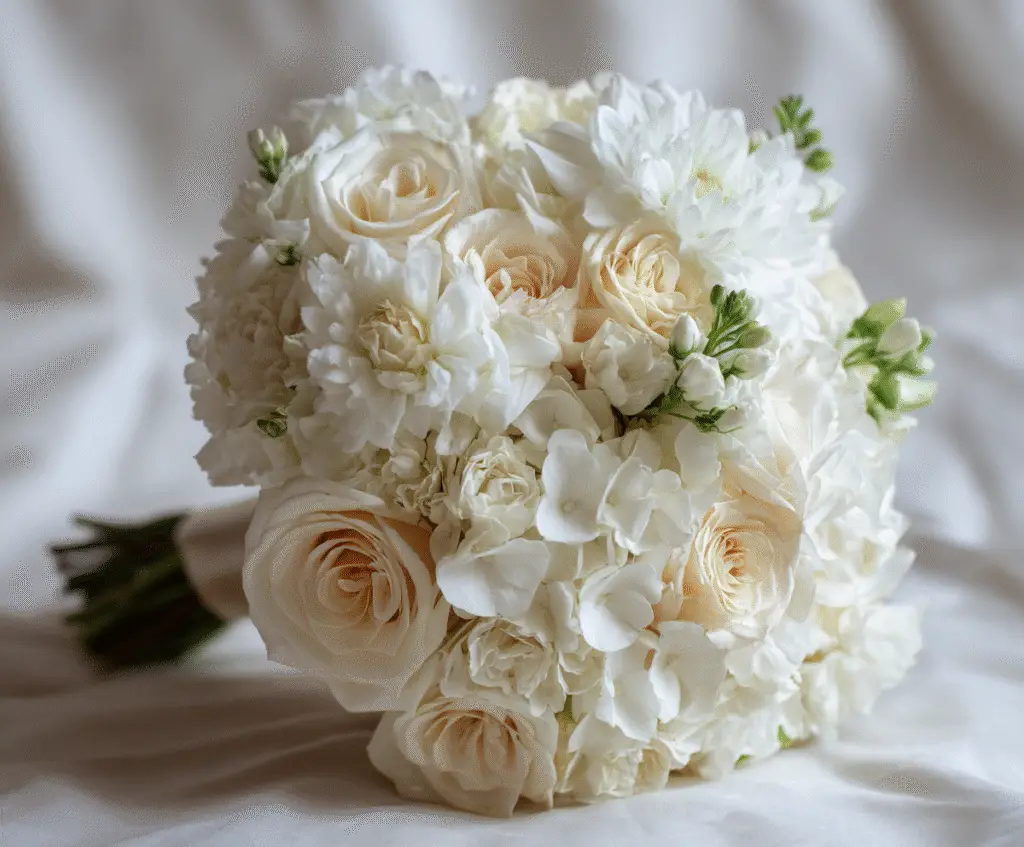
White feels classic, clean, and bright in photos. Use roses, ranunculus, lisianthus, hydrangea, stock, phalaenopsis orchids, and anemones. Add textural neutrals such as astilbe, Queen Anne’s lace, and dusty miller. Finish with dark centers or deep greenery if you want contrast. Keep whites warm or cool rather than mixing both. In candlelit rooms, ivory reads softer than pure white. Ask your photographer how white balance will be handled so flowers do not appear bluish.
Blush and soft pink
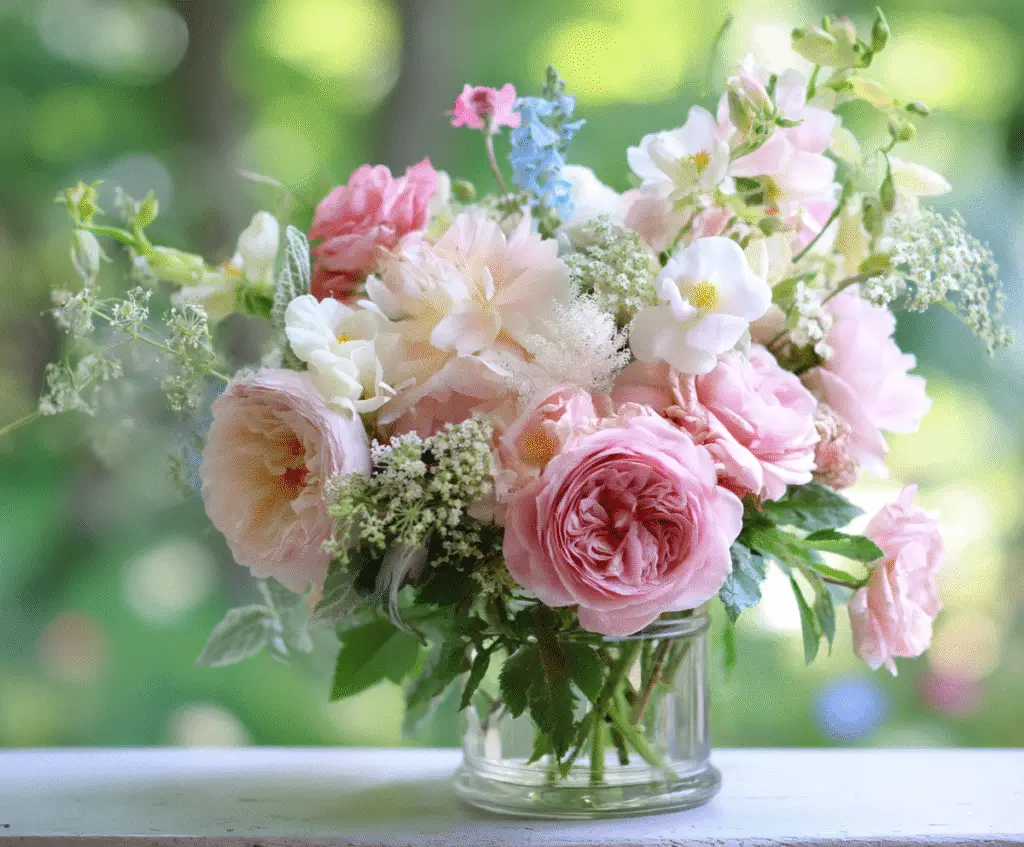
Blush is flattering on skin and timeless in portraits. Choose garden roses, ranunculus, lisianthus, sweet peas, and peonies in late spring. Balance sweetness with taupe, champagne, and soft sage foliage. Avoid mixing blush with bright red unless you want strong contrast. For a modern look, pair blush with sandy beige and cappuccino tones. For an airy look, keep vessels light and transparent. For a cottage mood, add spirea or Queen Anne’s lace.
Red and burgundy
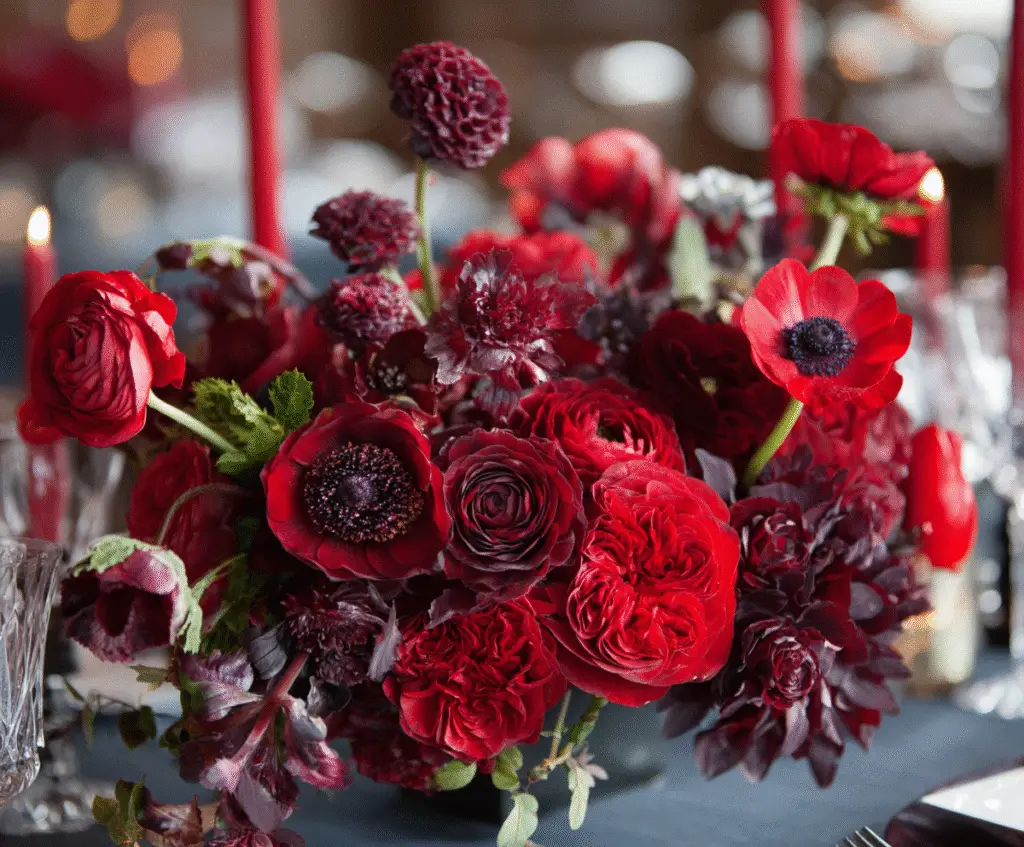
Red is dramatic and works well in winter or formal ballrooms. Use roses, ranunculus, anemones, scabiosa, amaryllis, and carnations for longevity. Deep greens and glossy foliage keep reds rich. Add burgundy textures with chocolate cosmos or tinted foliage. In bright sun, deep reds can go flat. Use layered tones from cherry to wine so the color photographs with depth. Avoid heavy fragrance near dining tables. A little goes a long way for napkin blooms and chair decor.
Peach and coral
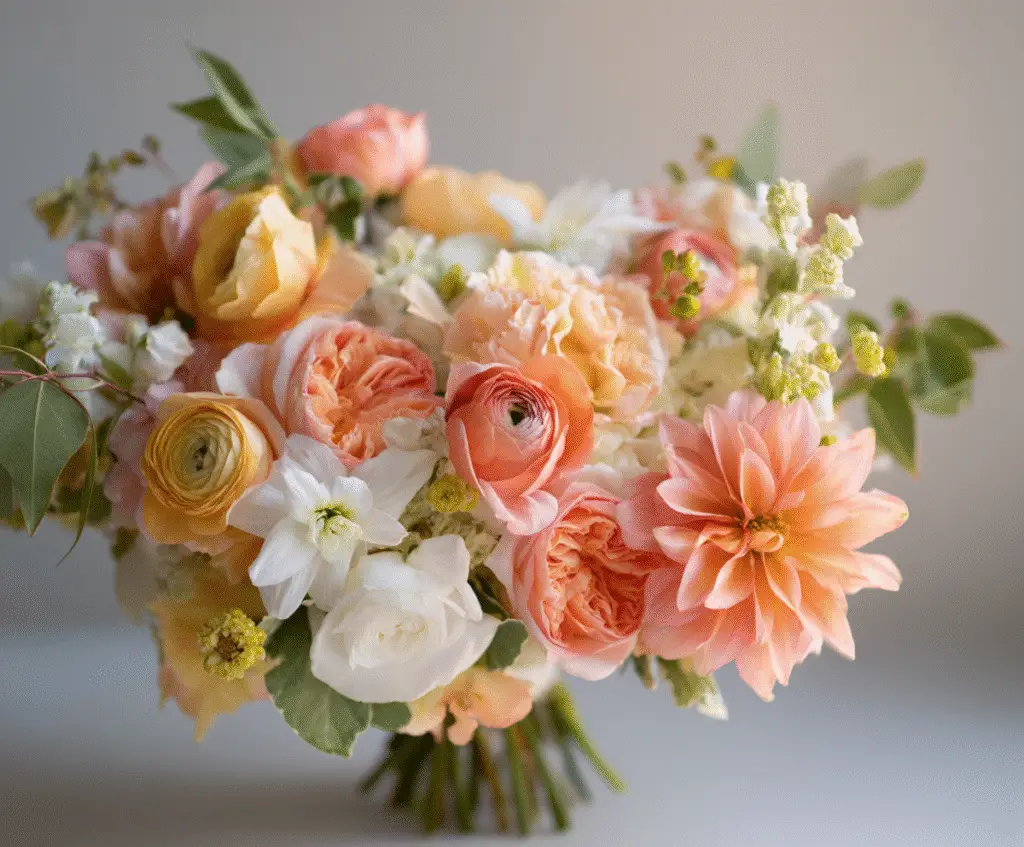
Peach feels fresh and happy in spring and summer. Use garden roses, ranunculus, dahlias, lisianthus, and stock. Combine with butter yellow and soft apricot for a sunrise vibe. Coral peonies are spectacular briefly in late spring. When they are out of season, coral roses and dahlias replicate the mood at lower cost. Warm metallics and wood tables enhance peach tones. For a beach wedding, coral pairs well with sand, stone, and bleached textures.
Yellow and butter
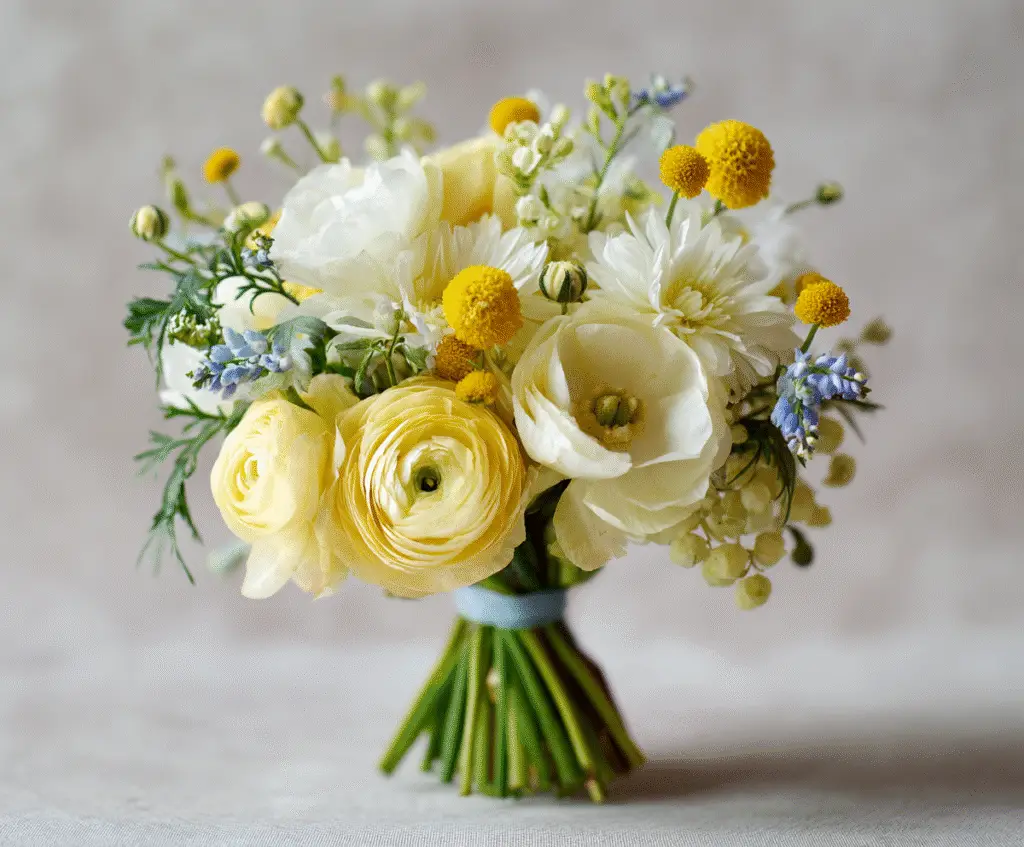
Yellow brings sunlight to indoor spaces and pairs beautifully with white and green. Use ranunculus, tulips, garden roses, chrysanthemums, and craspedia for playful dots. Keep shapes simple so yellow does not overwhelm. Butter yellow reads luxurious in candlelight. Bright lemon suits outdoor summer parties. A pale yellow bouquet with white and a hint of blue is elegant without feeling childlike.
Blue and powder blue
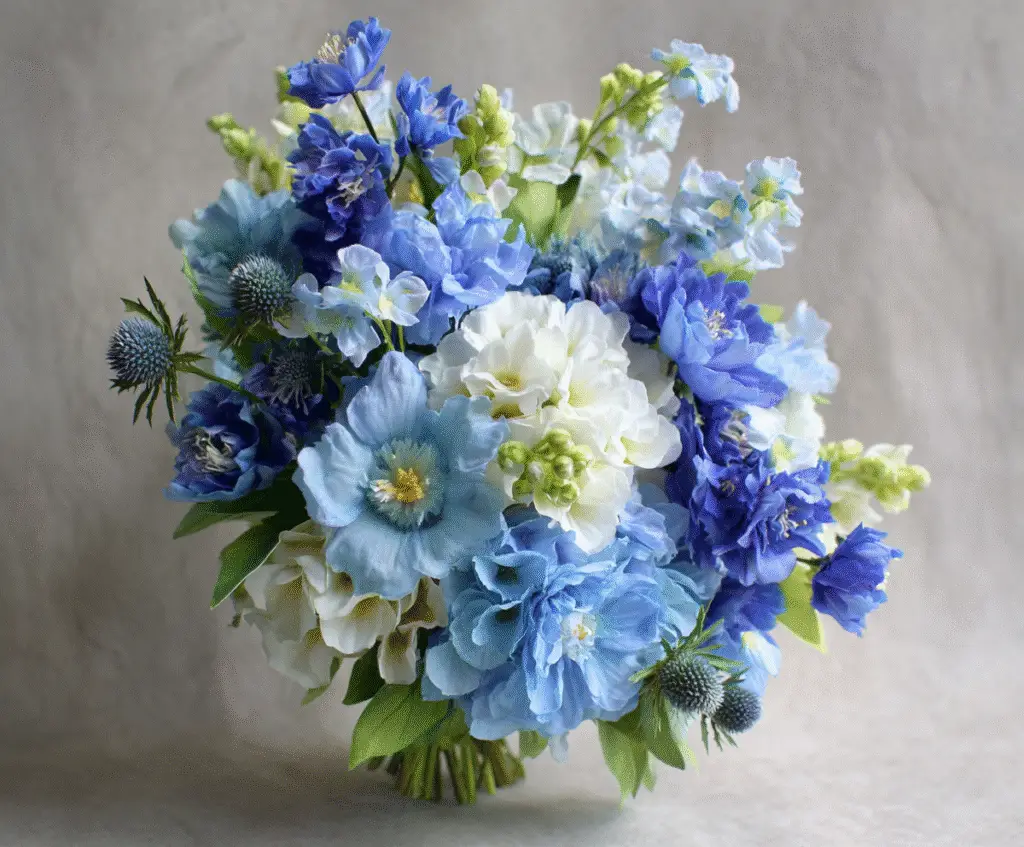
True blue flowers are limited which makes them special. Use delphinium, cornflower, tweedia, hydrangea, eryngium, and forget me not. Blue calms a hot palette and brings coastal energy. Hydrangea fills volume at a good price and needs deep water. Tweedia adds the softest sky blue for boutonnieres. Balance blue with white and clean greens so the palette stays crisp. Avoid mixing blue with too many warm pastels unless you want a watercolor effect.
Lavender and purple
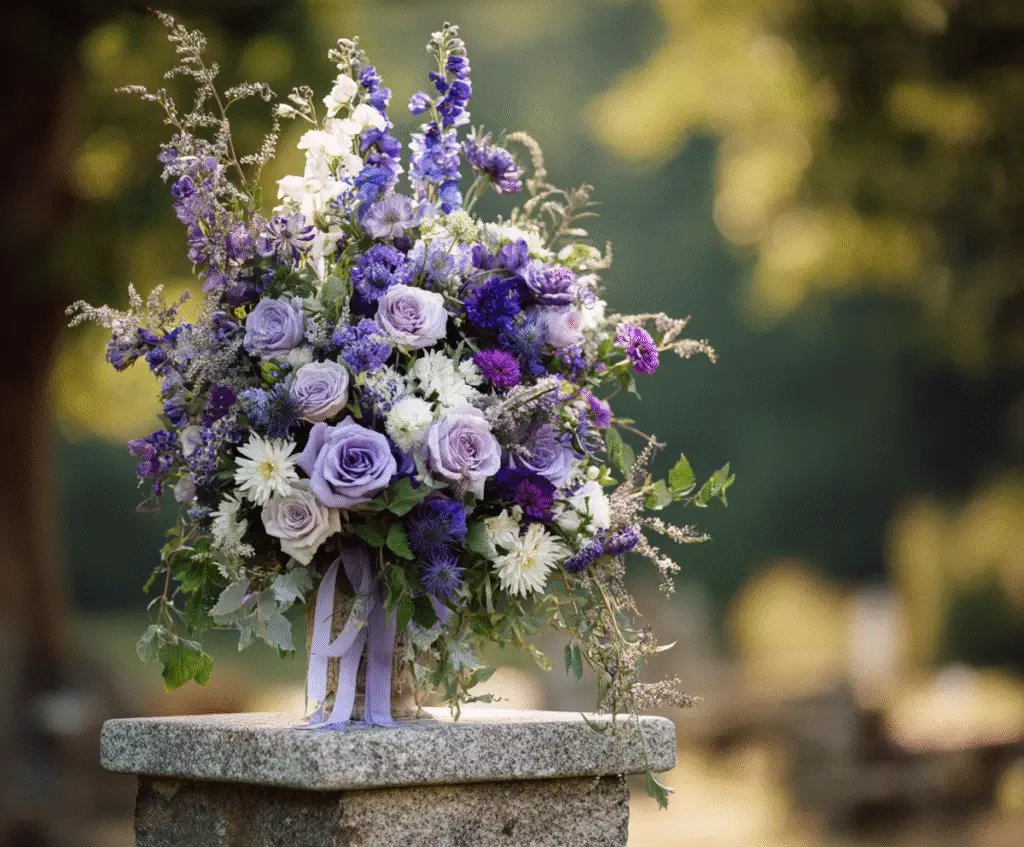
Lavender feels romantic and slightly mysterious. Use roses, lisianthus, delphinium, stock, clematis, scabiosa, and chrysanthemums. Add fresh herbs like lavender or rosemary for scent in outdoor ceremonies. Deep plum anchors the palette for fall. Pair lavender with gray greens for a gentle mood. For indoor spaces with low light, increase white to prevent the palette from going dull.
Green and neutral textures
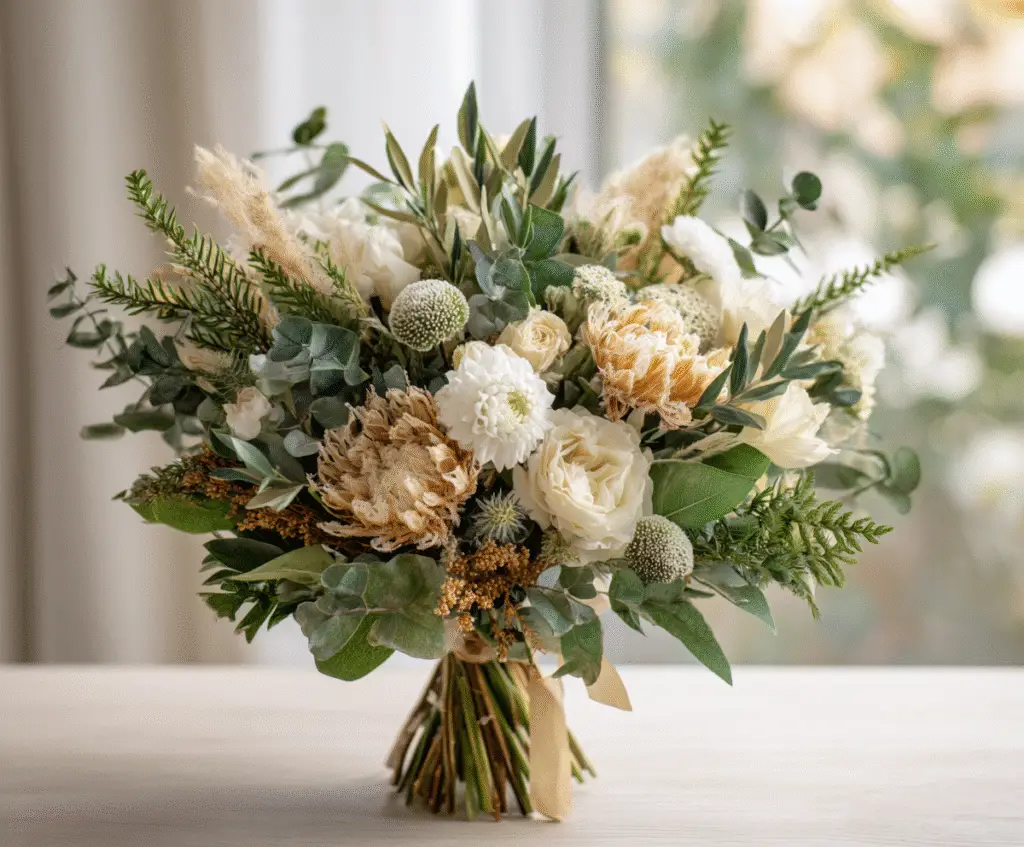
Green is a color in its own right. Olive, eucalyptus, ruscus, salal, and ferns create movement and scale. Green heavy designs reduce cost without feeling sparse. Add white, beige, and sand toned blooms to soften the look. Consider potted herbs or small olive trees for aisles and entryways. In winter, evergreen branches give structure and fragrance. In summer, airy grasses feel modern and light.
Cultural and regional touches
Many couples honor family traditions through flowers. A few ideas travel well. In Italy, olive and lemon branch decor signals hospitality and pairs with cream roses and herbs. In France, lavender and garden roses feel at home in stone courtyards. In the United Kingdom, seasonal garden mixes with foxglove, delphinium, and roses create romantic borders. In India, marigold and jasmine garlands bring color and scent to mandap and baraat celebrations. In Japan, branches of cherry blossom or maple add seasonal elegance to entries. In Mexico, bold colors, dahlias, and papel inspired textures create joyful energy. Always confirm what your venue allows and what your guests will appreciate. The heart of the tradition matters more than strict rules.
Fragrance, allergies, and safety
Comfort keeps guests present for the moments that matter. If you know you have hay fever or migraine triggers, limit strong scents such as lilies, tuberose, gardenia, and stock in enclosed rooms. Choose low fragrance roses, ranunculus, lisianthus, and orchids for tables. Remove lily pollen to prevent stains on attire. Keep flowers away from open flames and heating vents. If cats will be present in getting ready spaces, avoid lilies because they are dangerous to cats. Skip edible flowers on desserts unless your baker provides food safe blooms. Ask your florist to confirm pesticide practices for any blooms that may touch food.